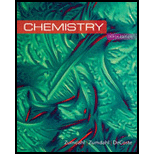
(a)
Interpretation: A proposed mechanism of a destruction of ozone in upper atmosphere and the first step mechanism for the chlorine catalyzed ozone destruction are given. The answers are to be stated for the given options.
Concept introduction: The substance that speeds up the
The intermediates are the transient species that is capable to produce the desired product directly.
To determine: The overall balanced equation for the destruction of ozone.
(b)
Interpretation: A proposed mechanism of a destruction of ozone in upper atmosphere and the first step mechanism for the chlorine catalyzed ozone destruction are given. The answers are to be stated for the given options.
Concept introduction: The substance that speeds up the rate of reaction without getting consumed itself in a chemical reaction is known as catalyst.
The intermediates are the transient species that is capable to produce the desired product directly.
To determine: The catalyst in the mechanism for the destruction of ozone in upper atmosphere.
(c)
Interpretation: A proposed mechanism of a destruction of ozone in upper atmosphere and the first step mechanism for the chlorine catalyzed ozone destruction are given. The answers are to be stated for the given options.
Concept introduction: The substance that speeds up the rate of reaction without getting consumed itself in a chemical reaction is known as catalyst.
The intermediates are the transient species that is capable to produce the desired product directly.
To determine: The intermediate in the mechanism of a destruction of ozone in upper atmosphere.
(d)
Interpretation: A proposed mechanism of a destruction of ozone in upper atmosphere and the first step mechanism for the chlorine catalyzed ozone destruction are given. The answers are to be stated for the given options.
Concept introduction: The substance that speeds up the rate of reaction without getting consumed itself in a chemical reaction is known as catalyst.
The intermediates are the transient species that is capable to produce the desired product directly.
To determine: The rate law, if first step is slow and second step is fast.
(e)
Interpretation: A proposed mechanism of a destruction of ozone in upper atmosphere and the first step mechanism for the chlorine catalyzed ozone destruction are given. The answers are to be stated for the given options.
Concept introduction: The substance that speeds up the rate of reaction without getting consumed itself in a chemical reaction is known as catalyst.
The intermediates are the transient species that is capable to produce the desired product directly.
To determine: The second step in the mechanism for chlorine catalyzed ozone destruction and the overall balanced equation.
Trending nowThis is a popular solution!

Chapter 20 Solutions
Bundle: Chemistry, Loose-leaf Version, 10th + Enhanced Webassign Printed Access Card For Chemistry, Multi-term Courses
- In the decomposition reaction in solution B → C, only species C absorbs UV radiation, but neither B nor the solvent absorbs. If we call At the absorbance measured at any time, A0 the absorbance at the beginning of the reaction, and A∞ the absorbance at the end of the reaction, which of the expressions is valid? We assume that Beer's law is fulfilled.arrow_forward> You are trying to decide if there is a single reagent you can add that will make the following synthesis possible without any other major side products: 1. ☑ CI 2. H3O+ O Draw the missing reagent X you think will make this synthesis work in the drawing area below. If there is no reagent that will make your desired product in good yield or without complications, just check the box under the drawing area and leave it blank. Click and drag to start drawing a structure. Explanation Check ? DO 18 Ar B © 2025 McGraw Hill LLC. All Rights Reserved. Terms of Use | Privacy Center | Accessibilityarrow_forwardDon't use ai to answer I will report you answerarrow_forward
- Consider a solution of 0.00304 moles of 4-nitrobenzoic acid (pKa = 3.442) dissolved in 25 mL water and titrated with 0.0991 M NaOH. Calculate the pH at the equivalence pointarrow_forwardWhat is the name of the following compound? SiMe3arrow_forwardK Draw the starting structure that would lead to the major product shown under the provided conditions. Drawing 1. NaNH2 2. PhCH2Br 4 57°F Sunny Q Searcharrow_forward
- 7 Draw the starting alkyl bromide that would produce this alkyne under these conditions. F Drawing 1. NaNH2, A 2. H3O+ £ 4 Temps to rise Tomorrow Q Search H2arrow_forward7 Comment on the general features of the predicted (extremely simplified) ¹H- NMR spectrum of lycopene that is provided below. 00 6 57 PPM 3 2 1 0arrow_forwardIndicate the compound formula: dimethyl iodide (propyl) sulfonium.arrow_forward
 Chemistry & Chemical ReactivityChemistryISBN:9781337399074Author:John C. Kotz, Paul M. Treichel, John Townsend, David TreichelPublisher:Cengage Learning
Chemistry & Chemical ReactivityChemistryISBN:9781337399074Author:John C. Kotz, Paul M. Treichel, John Townsend, David TreichelPublisher:Cengage Learning Chemistry & Chemical ReactivityChemistryISBN:9781133949640Author:John C. Kotz, Paul M. Treichel, John Townsend, David TreichelPublisher:Cengage Learning
Chemistry & Chemical ReactivityChemistryISBN:9781133949640Author:John C. Kotz, Paul M. Treichel, John Townsend, David TreichelPublisher:Cengage Learning Chemistry for Engineering StudentsChemistryISBN:9781337398909Author:Lawrence S. Brown, Tom HolmePublisher:Cengage Learning
Chemistry for Engineering StudentsChemistryISBN:9781337398909Author:Lawrence S. Brown, Tom HolmePublisher:Cengage Learning ChemistryChemistryISBN:9781305957404Author:Steven S. Zumdahl, Susan A. Zumdahl, Donald J. DeCostePublisher:Cengage Learning
ChemistryChemistryISBN:9781305957404Author:Steven S. Zumdahl, Susan A. Zumdahl, Donald J. DeCostePublisher:Cengage Learning
 Chemistry: Principles and PracticeChemistryISBN:9780534420123Author:Daniel L. Reger, Scott R. Goode, David W. Ball, Edward MercerPublisher:Cengage Learning
Chemistry: Principles and PracticeChemistryISBN:9780534420123Author:Daniel L. Reger, Scott R. Goode, David W. Ball, Edward MercerPublisher:Cengage Learning





